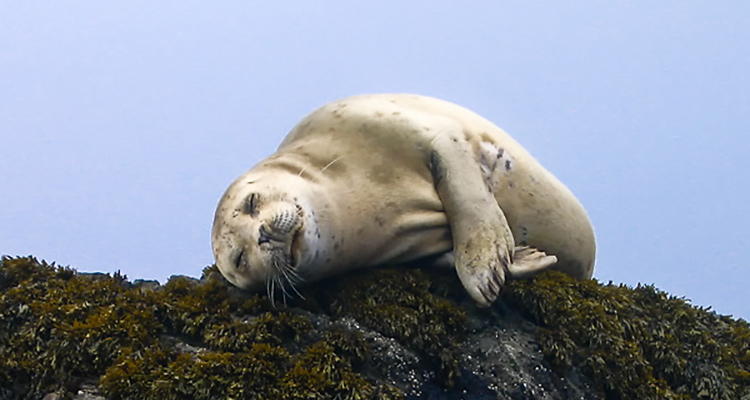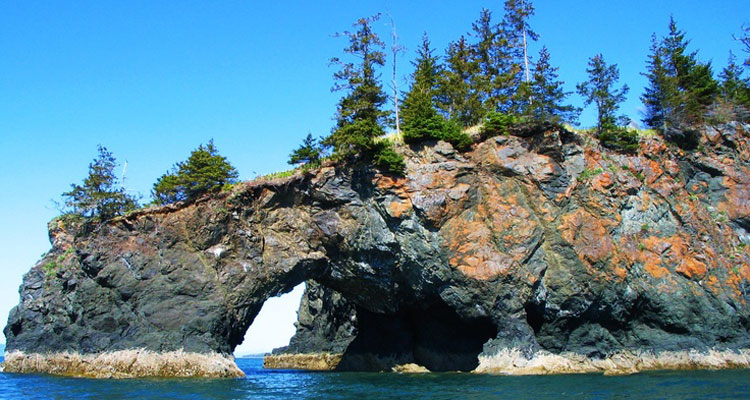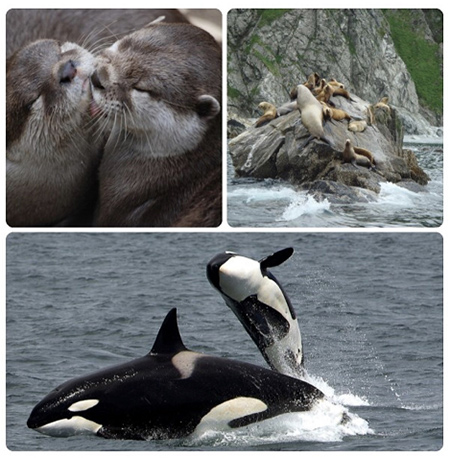Scenic Kachemak Bay State Park Tours
Kachemak Bay, located near Homer, Alaska, is a breathtaking destination renowned for its rich biodiversity and stunning landscapes. Wildlife tours led by 49 North Alaskan Adventures offer an unforgettable two-hour experience showcasing the bay’s natural wonders and cultural heritage. These tours are conducted aboard a fleet of custom-built Alaska boats, (create internal link to boats page) specifically designed for comfort, safety, and optimal wildlife viewing in the bay’s unique conditions.
The bay’s unique geography includes fjords, tidal flats, and glacial-fed waters, creating an ecosystem that supports marine mammals, seabirds, and intertidal life. Visitors frequently spot playful sea otters and harbor seals near the harbor. Occasionally, humpback whales, orcas, and gray whales make appearances, adding excitement to the Homer Alaska Wildlife Tour.
Birdwatchers will delight in observing over 200 species of birds, with Gull Island being a major highlight. This seabird sanctuary is home to thousands of birds, including puffins, kittiwakes, murres, and cormorants. Gull Island’s proximity to nutrient-rich waters makes it an essential habitat for breeding seabirds and a key stop on most marine wildlife tours.
Each spring, the Kachemak Bay Shorebird Festival (create link to our shorebirds festival page here) celebrates the arrival of over 100,000 migrating shorebirds. This event features guided walks, seminars, and boat tours, aligning perfectly with wildlife excursions. It’s a vibrant time to witness avian biodiversity and learn about conservation efforts while enjoying a Homer, Alaska marine wildlife tour.
In just two hours, these tours provide a compact yet comprehensive journey into Kachemak Bay’s wonders. From charismatic marine mammals and vibrant seabird colonies to cultural insights and intertidal discoveries, this Homer, Alaska wildlife tour promises memories to last a lifetime. Whether you’re a nature enthusiast, a bird lover, or simply seeking a unique Alaskan experience, a Homer Wildlife Tour is a must-do.
Why Take a Two-Hour Kachemak Bay Wildlife Tour
• Compact Yet Comprehensive Adventure
In just two hours, you can experience the highlights of Homer, Alaska’s extraordinary ecosystem without committing to a full day, making it perfect for travelers on tight schedules.
• Close Encounters With Wildlife
These tours frequently offer sightings of playful sea otters and curious harbor seals, often before the boat even leaves the harbor. Occasionally, humpback whales, orcas, and gray whales grace visitors with their presence (5%-10% chance), adding excitement to a Homer, Alaska wildlife tour.
• A Birdwatcher’s Paradise
Witness over 200 bird species, including puffins, bald eagles, kittiwakes, and cormorants. Gull Island, a key stop, is home to one of the largest seabird colonies in the region and a highlight of any Kachemak Bay wildlife tour experience.
• Breathtaking Scenery
Marvel at dramatic fjords, lush forests, and pristine tidal flats that define the rugged beauty of Homer, Alaska.
• Effortless Accessibility
Two-hour tours are family-friendly and require no extensive preparation, making them accessible for visitors of all ages and activity levels.
• Guided by Experts
Knowledgeable guides from 49 North Alaskan Adventures enrich the experience by sharing insights into the bay’s ecology, history, and conservation efforts during your Homer, wildlife tour.
• Cultural Connection
Learn about the Indigenous Alutiiq heritage and modern fishing communities that have shaped Homer, Alaska’s unique character.
• Seasonal Highlights
Depending on the time of year, witness spectacular events like the spring migration of shorebirds celebrated during the Kachemak Bay Shorebird Festival, perfectly complementing a Homer, Alaska wildlife tour
• Memories for a Lifetime
From capturing stunning photographs to observing rare wildlife, a two-hour tour offers moments that will stay with you forever, making a Homer, Alaska wildlife tour an unforgettable experience.


Exploring the Wonders of Kachemak Bay Wildlife Tours in Homer, Alaska
Nestled on the southern edge of Alaska’s Kenai Peninsula, Kachemak Bay offers an unparalleled blend of breathtaking landscapes and rich biodiversity. Known for its pristine waters, dramatic fjords, and abundant wildlife, Kachemak Bay has earned its reputation as a must-visit destination for nature enthusiasts. Wildlife tours departing from Homer, Alaska provide an intimate glimpse into this unique ecosystem, and 49 North Alaskan Adventures ensures these tours are both enriching and unforgettable. These excursions can also be described as a Homer Wildlife Tour, allowing visitors to experience the region’s natural splendor up close.
The Unique Geography and Ecology of Kachemak Bay
Kachemak Bay stretches approximately 40 miles in length and 6 miles in width, forming a fjord that opens into Cook Inlet. Its diverse topography includes tidal flats, rocky shores, lush forests, and glacial-fed waters. This variety creates an ecosystem teeming with life, making it one of the most biologically productive marine environments in the world. The interplay of currents and nutrient-rich waters fosters an ideal habitat for countless marine and avian species.
What Makes Wildlife Tours in Kachemak Bay Special?
Wildlife tours in Kachemak Bay are unique because they combine marine exploration, birdwatching, and cultural experiences. Each two-hour excursion offers a chance to observe marine mammals like sea otters, harbor seals, and whales, alongside a wide array of seabirds such as puffins and kittiwakes. It’s important to note that while whales are a highlight, sightings are relatively rare, occurring only about 5%-10% of the time. The types of whales occasionally seen include humpback whales, orcas, and gray whales. Visitors are often delighted by harbor seals and sea otters, which are commonly spotted even before the tour leaves the harbor.
The bay’s remote islands and coves also reveal human history, from ancient Alutiiq sites to modern fishing communities. 49 North Alaskan Adventures ensures these elements are woven into the tour experience.
Key Wildlife Highlights
Marine Mammals
Kachemak Bay’s marine mammal population is a highlight of any wildlife tour. Visitors often encounter:
• Sea Otters: These charismatic creatures are frequently seen floating in rafts near the shoreline. Their playful antics and ecological importance as keystone species make them a favorite among tourists.
• Harbor Seals: Known for their curious nature, harbor seals are often spotted sunbathing on rocky outcrops or swimming near the harbor.
• Whales: Although sightings are not guaranteed, the chance to spot humpback whales, orcas, or gray whales adds an element of excitement to the tours.
Birdwatching Paradise
Kachemak Bay is home to over 200 bird species, making it a premier destination for birdwatchers. Some notable species include:
• Tufted and Horned Puffins: These iconic seabirds nest on rocky cliffs and delight visitors with their colorful beaks and charming flight patterns.
• Bald Eagles: Often seen perched high in trees or soaring over the bay, bald eagles are a symbol of Alaskan wilderness.
• Common Murres and Cormorants: These diving birds can be observed fishing in the bay’s nutrient-rich waters.
Intertidal Wonders
The tidal flats of Kachemak Bay are a treasure trove of intertidal life. Wildlife tours often include stops where visitors can explore tide pools teeming with sea stars, anemones, and crabs.
Gull Island: A Birdwatcher’s Paradise
Gull Island is a true highlight of any Kachemak Bay wildlife tour and a stop on nearly all excursions led by 49 North Alaskan Adventures. Located just a short boat ride from Homer, this rocky islet is a bustling seabird sanctuary, home to tens of thousands of birds representing multiple species.
Bird Species on Gull Island
Gull Island supports one of the largest seabird colonies in Kachemak Bay. Visitors can observe:
• Black-legged Kittiwakes: These small, graceful gulls dominate the island, creating a cacophony of sound as they nest and feed.
• Tufted and Horned Puffins: Nesting on the island’s rocky cliffs, puffins are a favorite sight for their vibrant colors and unique behaviors.
• Common Murres: Large numbers of these diving birds can be seen packed tightly on the island’s ledges.
• Pelagic Cormorants: With their sleek black bodies and iridescent feathers, cormorants are a striking presence.
The Importance of Gull Island.
Gull Island is a small yet ecologically significant seabird rookery located in Kachemak Bay near Homer, Alaska. Its steep, rocky cliffs shelter tens of thousands of birds during the nesting season, including black-legged kittiwakes, tufted and horned puffins, common murres, and pelagic cormorants. Nutrient-rich waters in the bay supply plentiful fish, making Gull Island a key breeding ground and an invaluable indicator for the health of the surrounding marine ecosystem. Visitors typically view the island from guided boat tours, which often provide naturalist-led educational insights about seabird ecology, conservation, and responsible wildlife viewing.
From late spring through mid-summer, our 49 North marine wildlife tours witness nesting, chick-rearing, and abundant bird activity. While landing on the island is not typically permitted, boats approach close enough for spectacular birdwatching and photography, especially during peak breeding months. Research and monitoring efforts by local organizations underscore the island’s importance, ensuring future generations can appreciate its vibrant wildlife and the broader ecological connections within Kachemak Bay.
Photographic Opportunities
While specialized photography tours are not offered, the stop at Gull Island provides plenty of opportunities to capture stunning images of wildlife and the surrounding scenery. The dramatic cliffs and vibrant activity of the birds make it a prime location for photographers of all skill levels.
Cultural and Historical Context
Kachemak Bay has been home to Indigenous Alutiiq people for thousands of years. Wildlife tours often incorporate visits to sites showcasing traditional practices, such as fish camps and ancient petroglyphs. Additionally, modern communities like Halibut Cove offer insight into the bay’s fishing and artistic culture.
The Kachemak Bay Shorebird Festival
Every spring, Homer plays host to the Kachemak Bay Shorebird Festival, an annual celebration of the incredible bird migration that graces the area. Held in early May, the festival marks the arrival of over 100,000 shorebirds from more than 25 species, making their way along the Pacific Flyway. For birdwatchers and nature enthusiasts, this is a pinnacle event that coincides beautifully with Kachemak Bay’s vibrant spring wildlife activity.
The festival offers a range of activities, including guided bird walks, expert-led seminars, and boat tours that align closely with wildlife excursions provided by 49 North Alaskan Adventures. Participants can deepen their understanding of migratory patterns and conservation efforts while enjoying the stunning landscapes of Kachemak Bay. Gull Island, a focal point during the festival, becomes even more dynamic as nesting seabirds add to the spectacle of migratory shorebirds in the area.
The Kachemak Bay Shorebird Festival is not just an opportunity to witness breathtaking avian biodiversity but also a time for community connection and education. The event emphasizes the importance of preserving the bay’s ecosystems for future generations, echoing the conservation values central to 49 North Alaskan Adventures.
Seasonal Variations in Wildlife Tours
The wildlife experience in Kachemak Bay varies with the seasons:
• Spring: Migratory birds arrive, and gray whales pass through during their migration. The Kachemak Bay Shorebird Festival adds a unique dimension to spring tours, highlighting the arrival of thousands of shorebirds.
• Summer: This is peak season for wildlife activity, with an abundance of marine mammals and nesting seabirds.
• Fall: Salmon runs attract bears to the area, and migratory birds begin their journey south.
• Winter: While quieter, winter tours offer the chance to see resident species like sea otters and bald eagles in a serene setting.
Sustainable Tourism Practices
Tour operators in Kachemak Bay, including 49 North Alaskan Adventures, are committed to preserving the environment through sustainable practices. These include:
• Leave No Trace Principles: Encouraging visitors to minimize their impact on the natural environment.
• Eco-Friendly Boats: Many operators use fuel-efficient vessels to reduce their carbon footprint.
• Education and Awareness: Guides emphasize the importance of conservation and share insights about the bay’s ecosystem.
Tips for a Memorable Wildlife Tour
• Dress Appropriately: Layered clothing, waterproof gear, and sturdy footwear are essential for Alaskan weather.
• Bring Binoculars and Cameras: These tools enhance your ability to observe and capture wildlife.
• Book in Advance: Tours fill up quickly, especially during the summer months.
• Listen to the Guides: Their expertise ensures a safe and enriching experience.


Don’t Wait to Book Your Kachemak Bay State Park Tour Today!
FAQ’s About Kachemak Bay Characteristics, Ecology & Wildlife
What makes Kachemak Bay unique?
Kachemak Bay is notable for its rich biodiversity and dramatic landscapes, including tidal flats, rocky shores, and fjords. Multiple currents converge here, creating a nutrient-rich environment that supports abundant marine life. This unique setting also offers opportunities for recreation, research, and education.
What is Kachemak Bay known for?
It’s known for being one of the most biologically productive marine environments in Alaska, with a high diversity of fish, seabirds, and marine mammals. Visitors also appreciate the bay’s stunning scenery, fishing opportunities, and nearby state park. Seasonal festivals and cultural events highlight its coastal heritage.
How deep is Kachemak Bay?
Kachemak Bay’s depth can reach over 500 feet in some areas, though it varies significantly. The fjord-like shape results in a complex underwater terrain. Deep waters, combined with strong tides, contribute to the bay’s rich ecological productivity.
How big is Kachemak Bay?
The bay spans roughly 40 miles in length and six miles in width. It encompasses a diverse range of habitats, from shallow tidal flats to deeper channels. This variety is a key factor in its abundant wildlife.
Is Kachemak Bay salt water?
Yes, Kachemak Bay is primarily salt water, connected directly to the Gulf of Alaska through lower Cook Inlet. However, freshwater from glacial streams and rivers also enters the bay. This mix of fresh and salt water contributes to its vibrant marine ecosystem.
Is Kachemak Bay protected?
Much of the surrounding area is protected through Kachemak Bay State Park and State Wilderness Park. Certain marine areas also have conservation measures in place. These protections aim to balance recreation, local use, and wildlife conservation.
Are there whales in Kachemak Bay?
Yes, whales such as humpbacks, orcas, and gray whales occasionally visit, but sightings can be sporadic. Many visitors spot sea otters and harbor seals more frequently. Whale-watching tours sometimes include Kachemak Bay in their routes.
What fish are in Kachemak Bay?
Salmon, halibut, cod, and various rockfish species are common, reflecting the bay’s nutrient-rich waters. The salmon runs, in particular, are important for both local fisheries and wildlife. Sportfishing is popular, with charters frequently departing from nearby Homer.
Can you swim in Kachemak Bay?
Yes, but the water is typically cold, and swimmers should be prepared with appropriate gear like a wetsuit. The bay’s strong tides and currents also warrant caution. Most people prefer kayaking, boating, or other forms of recreation over open-water swimming.
What is the head of Kachemak Bay?
Kachemak Bay State Park, Activities, & Wildlife
The head of Kachemak Bay refers to the innermost portion of the bay, near where rivers and glacial runoff flow into it. This region often includes mudflats and estuary habitats. It’s a dynamic area influenced by tidal fluctuations.
Where is the head of the bay in Alaska?
In this context, it refers to the northern end of Kachemak Bay, just east of Homer. This area features shallow waters, intertidal flats, and significant bird activity. It’s easily reachable by road and local water taxis.
How do I get to Kachemak Bay State Park?
Most visitors reach the park via water taxi or private boat from Homer. There are no roads leading directly into the park, so planning ahead for boat transport is essential. Seasonal services can vary, so it’s wise to confirm schedules in advance.
Can you drive to Kachemak Bay State Park?
No, you cannot drive directly to the park. The rugged terrain and lack of roads mean water-based access is the norm. This limited access helps preserve the park’s wilderness character.
What is there to do in Kachemak Bay State Park?
Popular activities include hiking scenic trails, viewing wildlife (such as bears and seabirds), fishing, and kayaking along the shoreline. Grewingk Glacier ((link to our Grewingk Glacier Page)) is a top attraction, offering spectacular views and a relatively accessible trail. Many visitors also enjoy overnight camping in designated areas.
Are there bears in Kachemak Bay State Park?
Yes, black bears and occasionally brown bears inhabit parts of the park. Visitors should follow bear safety guidelines, like storing food properly and making noise on trails. Sightings can be a highlight, but caution is always advised.
FAQ’s About Homer, Alaska, General Information, Geography, The Spit & Grewingk Glacier
What is special about Homer, Alaska?
Homer is known as the “Halibut Fishing Capital of the World” and boasts stunning views of Kachemak Bay. Its vibrant arts scene and rich maritime heritage also draw visitors. The Homer Spit is an iconic landmark that encapsulates the town’s coastal charm.
What are two interesting facts about Homer?
First, the Homer Spit is a 4.5-mile strip of land extending into Kachemak Bay, formed by glacial deposits. Second, Homer is home to a thriving artist community, featuring numerous galleries and studios that celebrate Alaskan culture and landscapes.
What body of water is Homer, Alaska on?
Homer is situated on the shores of Kachemak Bay, which connects to the larger Cook Inlet and the Gulf of Alaska. This maritime setting greatly influences the town’s fishing and tourism industries. Marine life is abundant in the bay’s nutrient-rich waters.
What island is Homer, Alaska on?
Homer isn’t actually on an island—it’s located on the Kenai Peninsula. Some confusion might arise because the surrounding area features numerous islands within Kachemak Bay. However, Homer itself is part of mainland Alaska via the peninsula.
How was Homer Spit formed?
Scientists believe the Spit was formed by glacial action and wave deposition over thousands of years. As glaciers retreated, they left behind sediment that ocean currents later shaped into the narrow strip of land you see today. Its dynamic geology continues to be influenced by storms and tidal changes.
Can you drive on the Homer Spit?
Yes, there’s a road along much of the Spit, lined with shops, restaurants, and harbor facilities. You can park in designated areas and explore the beaches or fishing spots. It’s a popular spot for tourists, especially in summer.
Why do they call it Homer Spit?
It’s commonly referred to as “the Spit” due to its long, thin shape that juts out into Kachemak Bay. Local lore credits early gold miners or fishermen with the name, though the exact origin isn’t fully documented. The name stuck and is now part of Homer’s identity.
How do I get to Grewingk Glacier?
Reachable by water taxi from Homer, Grewingk Glacier is accessed through Kachemak Bay State Park. A popular choice is landing at the Halibut Cove Lagoon trailhead, followed by a moderate hike to the glacier overlook. Plan for a few hours round trip and check water taxi schedules. (link to our Grewingk Glacier Page)
How long is the Grewingk Glacier hike?
The Grewingk Glacier Trail is typically 3–4 miles one way, depending on the route you take. Most hikers complete it in a few hours, but times vary with fitness and weather. The trail offers picturesque views of the glacier, forests, and meadows along the way. (link to our Grewingk Glacier Page)

